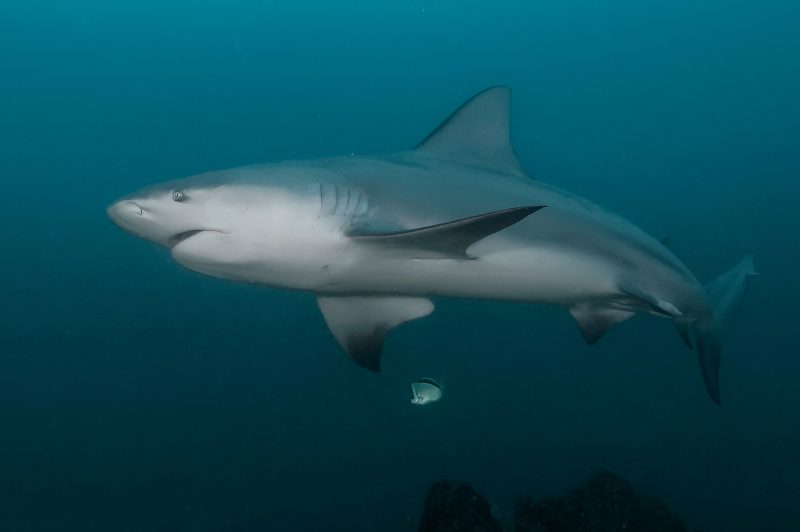Louisiana’s waters—where vast river deltas meet the Gulf of Mexico—are full of life. From alligators to catfish, redfish to pelicans, the ecosystem teems with diversity. But among these familiar creatures swims one of nature’s most powerful and misunderstood predators: the bull shark.
Few realize that bull sharks, known scientifically as Carcharhinus leucas, inhabit not just the salty Gulf, but also the freshwater rivers and bayous of Louisiana. They are among the only shark species capable of living in both salt and fresh water, and they have been found far upstream in the Mississippi River, hundreds of miles from the ocean.
In this article, we’ll uncover the secrets about bull sharks in Louisiana waters—their biology, feeding habits, surprising inland travels, and the vital role they play in the ecosystem. These adaptable predators are both fascinating and formidable, revealing the mysterious connection between Louisiana’s rivers and the sea.
Understanding the Bull Shark

A Shark Like No Other
The bull shark is one of the most adaptable fish on Earth. Its name comes from its stocky build, blunt snout, and aggressive nature. Reaching up to 11 feet long and weighing more than 500 pounds, it’s among the most powerful predators in coastal and estuarine waters.
What sets bull sharks apart is their ability to tolerate freshwater. Unlike most sharks that need salt to regulate their body chemistry, bull sharks possess a unique physiological system that allows them to maintain salt levels in both fresh and brackish environments.
Distinctive Features
- Coloration: Grayish on top with a white underside, ideal for camouflage in shallow water.
- Teeth: Broad, serrated, and designed to crush and tear.
- Eyes: Small and adapted for murky water, perfect for Louisiana’s sediment-filled rivers.
- Behavior: Solitary and territorial, though they occasionally form loose groups around abundant prey.
A True Freshwater Traveler
Bull sharks have been found as far as Alton, Illinois, over 1,000 miles up the Mississippi River from the Gulf. In Louisiana, sightings are common in the Atchafalaya Basin, Lake Pontchartrain, and even in Red River tributaries.
Their presence in freshwater is not accidental—it’s a deliberate adaptation for survival and reproduction.
The Science Behind Their Freshwater Adaptation
Osmoregulation: Nature’s Balancing Act
Fish depend on salt balance for survival. Most sharks would die in freshwater because their bodies lose sodium and chloride too quickly. However, bull sharks have evolved specialized kidneys and rectal glands that adjust salt retention levels.
In freshwater, these organs reduce salt loss and increase urea production, preventing dehydration. In saltwater, the process reverses. This flexibility gives them access to habitats unavailable to other sharks, allowing them to hunt, breed, and thrive across a range of environments.
Why Move Inland?
Bull sharks enter rivers and lakes for several reasons:
- Breeding: Freshwater provides protection from larger marine predators that target young sharks.
- Feeding: Rivers are rich in fish, turtles, and other prey.
- Temperature Regulation: Shallow freshwater warms quickly, speeding metabolism and growth.
This remarkable adaptation makes them one of Louisiana’s most elusive apex predators.
Bull Sharks in Louisiana: Where They’re Found
The Mississippi River
Perhaps the most famous bull shark sightings occur in the Mississippi River. Reports date back to the 1930s, with confirmed catches near St. Louis, Baton Rouge, and New Orleans. These sharks navigate the brackish delta with ease and occasionally venture far upstream during warm months.
Lake Pontchartrain
One of the most well-documented bull shark habitats in Louisiana is Lake Pontchartrain. Despite being a brackish lake, it’s connected to the Gulf via the Rigolets and Chef Menteur Pass. Every summer, bull sharks migrate into the lake to feed on mullet, catfish, and crabs.
While rare, some have been spotted near swimming areas, prompting temporary warnings—but attacks are almost unheard of.
The Atchafalaya Basin and Bayous
In south-central Louisiana, the Atchafalaya Basin—a mix of swamps, rivers, and backwaters—offers prime hunting grounds for bull sharks. Murky, slow-moving waters make it ideal for ambush hunting. Fishermen occasionally hook young bull sharks while targeting catfish or redfish near estuaries.
Feeding Habits and Hunting Behavior
Opportunistic Predators
Bull sharks are opportunistic feeders. Their diet includes:
- Fish such as mullet, catfish, and red drum
- Rays and smaller sharks
- Crustaceans and turtles
- Occasionally, birds or mammals near the surface
Their powerful jaws can crush shellfish and snap bones with ease.
Hunting Style
Unlike open-ocean hunters that rely on sight, bull sharks use electroreception—detecting tiny electric signals emitted by prey. This makes them highly effective in Louisiana’s turbid waters.
They are ambush predators, often waiting motionless near the bottom before striking with explosive speed. Their short, muscular bodies allow them to make sharp turns and rapid lunges in confined waterways.
Breeding and Life Cycle
Mating and Birthing
Bull sharks give birth to live young rather than laying eggs. Mating occurs in warm, shallow coastal waters, and gestation lasts about 10 to 11 months. Females give birth to 1–13 pups in estuaries or river mouths—safe nurseries where salinity is low.
In Louisiana, these nurseries are often found in:
- Lake Pontchartrain and surrounding marshes
- Atchafalaya River Delta
- Coastal bayous and shallow estuaries
The young remain in these brackish waters for several years before moving out to sea.
Growth and Lifespan
Bull sharks grow quickly during their first few years, feeding heavily on small fish and crustaceans. They can live for 16 years or more, reaching maturity around age 10 for females and 8 for males.
Are Bull Sharks Dangerous to Humans?
The Reputation
Bull sharks have a fearsome reputation as one of the most aggressive shark species. They are responsible for a significant number of unprovoked attacks worldwide, along with tiger and great white sharks.
Their aggressive nature and preference for shallow waters bring them closer to humans than most sharks. However, in Louisiana, encounters are extremely rare.
Why Attacks Are Uncommon
- Low visibility waters make deliberate attacks unlikely—bull sharks often mistake splashing for prey.
- Most encounters occur near estuaries or boat launches, not swimming beaches.
- The majority of Louisiana’s bull sharks feed at night or in remote river systems far from people.
Safety Tips
For those fishing, boating, or swimming in coastal Louisiana:
- Avoid swimming at dusk or dawn.
- Don’t enter the water with open wounds.
- Refrain from throwing fish remains near docks or shorelines.
Respecting the shark’s habitat ensures safe coexistence.
Ecological Role of Bull Sharks
Apex Predators of the Delta
As apex predators, bull sharks are critical for maintaining balance in Louisiana’s aquatic ecosystems. They control populations of mid-sized fish, preventing overgrazing on smaller species and vegetation.
Their presence helps sustain biodiversity and water quality, keeping ecosystems like the Mississippi Delta healthy.
The Indicator of Ecosystem Health
Because bull sharks rely on both salt and freshwater, their presence indicates a thriving connection between river and ocean systems. Their absence could signal pollution, overfishing, or habitat fragmentation.
Myths and Misconceptions
Myth |
Truth |
|---|---|
Bull sharks live only in the ocean. |
False. They regularly swim into rivers and lakes. |
They attack humans frequently. |
Rare in Louisiana; most incidents occur elsewhere. |
Freshwater kills sharks. |
Bull sharks uniquely survive in both fresh and salt water. |
They can’t live far from the coast. |
Verified sightings exist over 1,000 miles inland. |
All sharks avoid muddy water. |
Bull sharks thrive in it, hunting by smell and vibration. |
Fascinating Facts About Louisiana’s Bull Sharks
- They can detect one drop of blood in a million gallons of water.
- They use the Earth’s magnetic field for navigation between the Gulf and rivers.
- Pregnant females often migrate upriver, where fewer predators threaten their pups.
- They’re one of the only sharks found in freshwater lakes like Lake Pontchartrain.
- Their liver oil helps with buoyancy, compensating for lack of a swim bladder.
- They can survive weeks in freshwater without returning to the ocean.
- Their bite force exceeds 1,300 pounds per square inch, among the highest of all sharks.
- Their body temperature adjusts to river water, making them remarkably adaptable.
Conservation and Human Impact
Threats Facing Bull Sharks
Despite their strength, bull sharks face serious challenges:
- Habitat loss from coastal development and damming.
- Pollution from agricultural runoff into rivers and estuaries.
- Overfishing, both intentional and as bycatch in shrimp trawls.
Legal Protection
While not endangered globally, bull sharks are classified as “Near Threatened” by the IUCN. Louisiana’s wildlife authorities monitor their populations to ensure sustainable coexistence.
The Importance of Research
Local scientists at Louisiana State University (LSU) and NOAA track shark migrations to better understand how these predators interact with changing water salinity and human activity. Satellite tagging and DNA studies are revealing migration routes crucial for conservation planning.
Coexisting With Louisiana’s River Sharks
Fishermen’s Encounters
For anglers, accidentally catching a bull shark in the Mississippi or Atchafalaya is a surprise—and a reminder of nature’s reach. Most fishermen release these sharks unharmed, understanding their ecological value.
Public Awareness
Education remains key. Many people still fear sharks due to myths perpetuated by media. In reality, humans pose a far greater threat to sharks than the reverse.
By protecting estuaries, reducing pollution, and supporting sustainable fisheries, Louisiana can safeguard not just its sharks but its entire coastal ecosystem.
FAQs About Bull Sharks in Louisiana
Are bull sharks common in Louisiana?
Yes, especially in coastal and brackish waters such as Lake Pontchartrain and the Atchafalaya Basin.
Can bull sharks live in freshwater?
Absolutely. They can survive and even thrive in freshwater rivers and lakes.
Are they dangerous to swimmers?
Not usually. Most bull sharks avoid humans and feed in remote waters.
What do they eat?
Fish, rays, turtles, and small mammals—virtually any prey available in their environment.
Do they migrate?
Yes. They travel between the Gulf of Mexico and inland rivers seasonally, especially during breeding months.
Conclusion
The bull sharks of Louisiana waters are living proof of nature’s adaptability and resilience. These powerful creatures bridge the worlds of salt and fresh water, revealing the deep interconnection between Louisiana’s rivers, bayous, and the Gulf.
While they may inspire fear, bull sharks are far from villains—they are indicators of healthy ecosystems and vital participants in the natural order.
Understanding and respecting these misunderstood predators allows Louisiana’s people and wildlife to coexist harmoniously, ensuring that both the rivers and their mysterious residents continue to thrive for generations to come.






